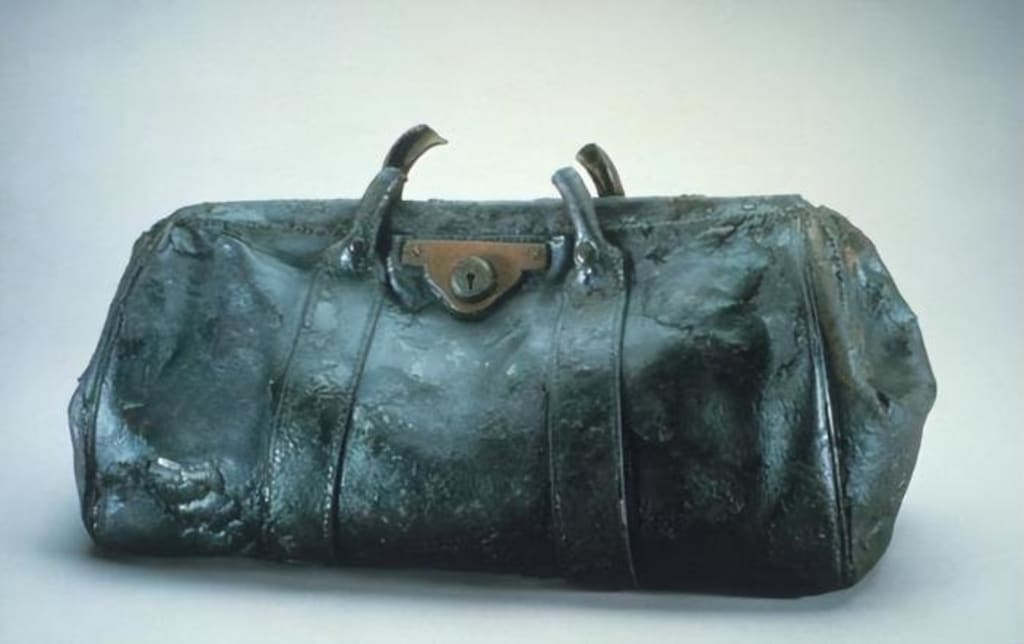Only two years after the sinking of the Titanic, 12 "artifacts" were recovered: including third-class cups of Chinese porcelain
In the two years since the discovery of the Titanic, researchers have made seven trips to the site of the remains

Since 1985-1987, two years after the discovery of the Titanic, researchers have visited the site of the remains seven times and recovered more than 5,500 artifacts. Here are a few of them.
crocodile leather bag
When British millinery Marion Meanwell boarded the Titanic, she had one luxury item in her belongings: a crocodile leather bag. Meanwell, who moved to the US to live with her daughter and grandchildren, was not supposed to be on the Titanic; she ended up getting a third-class ticket after another ship she was scheduled to travel on ceased service. In her bag were her marriage certificate, a canary receipt she shipped for relatives, and a note from a former landlord certifying her ability to pay rent reliably.
The documents survived because they were in her purse, which shielded the contents from the marine environment. As conservator David Galusha told The New York Times, "The thickness and quality of crocodile skin can't compare to what you find today. There was a general attitude back then to make things stand the test of time." Sadly Yes, Meanwell died when the Titanic sank.
(perfume bottle)
During a salvage mission in 2000, researchers grabbed a leather bag and, as salvage expert Dik Barton told ABC News in 2001, "we didn't know what we found until we got to the surface." When they When taking the bag to the laboratory on board and opening it, "the whole laboratory is filled with the scent of Edwardian perfume.
The bag contained small bottles of perfume samples, some of them broken, belonging to perfume maker Salfield, 47, a first-class passenger from Manchester. Several other bags bearing his name were also found, all containing samples of the perfume - 62 in all. Field, who survived the disaster, left the bags behind as he fled the ship.
After being salvaged from the depths, Salfield's scent has a second life: According to the ABC, the fragrance "is broken down into chemicals to reproduce the scent". The result is Legacy 1912, which, according to QVC, has "a delicate scent of lemon and orange blossom, as well as rosy rose and a warm, sheer amber color". The packaging design is based on a door taken from a sunken ship.
bronze cherub
In 1987, researchers brought a rare artifact: a bronze cherub, a light fixture on the ship's stairs. Exactly which one seems to be a matter of debate; one theory suggests that it came from "the upper landing of the first-class grand staircase, as it is smaller than the cherub on the main landing." The statue's torch and left foot are missing, Those parts may have been lost when it twisted off the post.
(gem bracelet)
The owner of this 'Amy' bracelet has never been identified
The bracelet has a 15 karat rose gold strap with a silver overlay, named Amy and set with diamonds. It was found in a leather bag that, according to the researchers, may have been left to the purser, as his duties included keeping passengers' valuables. The owner has never been officially identified, but in the book Titanic: Women and Children First, Judith B. Gellar speculates that it may belong to third-class passenger Amy Stanley, who was on her way to Connecticut for The Dane family works in New Haven, Connecticut. She appears to be the only person named Amy on the Titanic and survived the disaster.
(deck bell)
Among the salvaged artifacts was a lookout named Frederick Fleet who rang the bronze deck bell when he spotted the iceberg. The clock was recovered in 1987.
(musical score)
At least two pieces of music were recovered from the wreck: "In Mobile Bay," a piece written around 1910, and "Take Your Arms Around Me, Darling" from the Broadway musical Mrs. Shirley. The latter piece belonged to Howard Irving, who was traveling the world with friends. The final part of their trip was the maiden voyage of the Titanic. However, Owen missed the ship, and he may have suffered a robbery shortly before the Titanic left, but his friends and his belongings managed to get on board. Tragically, Owen's friend Henry Suterhall Jr. was killed in the sinking. The score was restored in 1993.
(Ratio table)
Marker gauge recovered from the wreckage of the Titanic.
This is a marker meter used to determine the speed and distance traveled by the ship, towed behind the Titanic. Beginning at noon on April 14, 1912, the device recorded 268 nautical miles.
(one piece of hull)
This 13-by-30-foot hull section is called the "chunk" - weighing in at 15 tons. It was first discovered in 1994 and was successfully salvaged in 1998 after a failure in 1996 when the cable holding the piece broke. Tom Zaller, then president of First Exhibition, told SF Gate in 2006 that the piece came from the starboard side of the ship, and when it was hauled up from the depths of the sea, it was covered in marine life, green and moss," after the restoration , this hull has undergone a desalination treatment to help slow rust and erosion.
(bowler hat)
Bowler hat recovered from the wreck of the Titanic
Unlike many other clothing items in the wreck, this bowler hat was a fashion accessory for men on the maiden voyage of the Titanic and was not protected by a bag or suitcase, but in any case relatively well preserved, it was recovered in 1993 .
third class cup
According to the researchers, only "elite" first-class passengers used cobalt blue and gold porcelain made by Spode Ceramics, which still exists today.
At the same time, it is likely that the crew also used third-class porcelain. According to the researchers, "Third-class china is open-stock white china with a single red white star line emblazoned on it, without the need for expensive hand decoration."
(Margaret "Molly" Brown's necklace)
In 1913, Brown filed a $27,887 insurance claim for property lost in the Titanic disaster. The items she claimed included two pairs of slippers, furs and 14 hats — and a necklace worth $20,000, or about $539,000 today. In 1987, researchers recovered a Granston bag containing a number of jewels, including a necklace with three unrefined gold nuggets believed to belong to Brown, whose husband worked in the mining industry .
About the Creator
sayre laylah
Tired of monotonous climbing moves, but every step is close to the top
Enjoyed the story? Support the Creator.
Subscribe for free to receive all their stories in your feed. You could also pledge your support or give them a one-off tip, letting them know you appreciate their work.






Comments
There are no comments for this story
Be the first to respond and start the conversation.